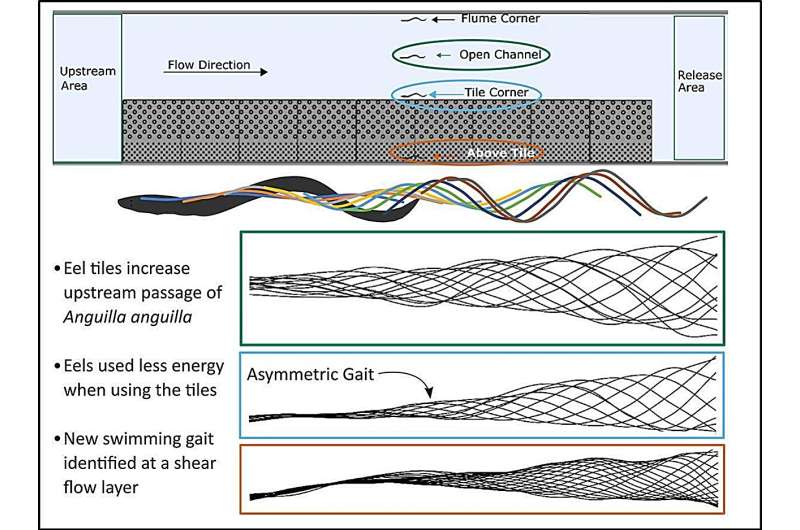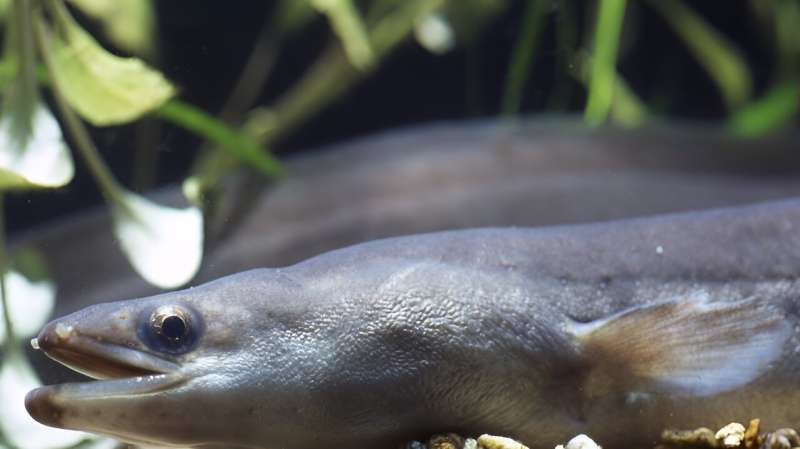This article has been reviewed according to Science X's editorial process and policies. Editors have highlighted the following attributes while ensuring the content's credibility:
fact-checked
peer-reviewed publication
trusted source
proofread
Textured tiles help endangered eels overcome human-made river obstacles, study shows

A new way of helping a critically endangered species of eel swim upstream during their migration has been tested by Cardiff University researchers.
The cheap and easy to retrofit method helps the fish overcome human-made obstacles such as culverts, weirs and flumes routinely used in UK waterways to enable river crossings via bridges and to regulate river flow.
The team tested specially designed tiles with textured surfaces under fast-flowing river conditions replicated in their labs at the University's School of Engineering.
The study, published in Ecological Engineering, found eels passed through in higher numbers when tiles were added to these high velocity sections, offering the ray-finned fish opportunities to rest and preserve energy for their journeys upstream.
Their findings offer conservationists a new fish passage solution that could help reconnect rivers for the European eel (Anguilla anguilla), potentially slowing down population decrease and benefitting the environment, the researchers say.
Mr. Guglielmo Sonnino Sorisio, a Ph.D. student at Cardiff University's School of Engineering and the study's lead author, said, "Juvenile eels migrating to fresh waters from the Sargasso Sea have so much to contend with, including shifting currents, polluted waters, chemical barriers, fishing pressures and disease."
He explained, "Our study tackles human-made physical barriers, which fragment, disconnect, and reduce habitat availability for the species. These structures, built to support road crossings and prevent flooding, produce high velocity flows which make it hard for the young eels to swim through.
"In our lab experiment, we showed that fitting tiles to the bed of large water channels, designed to represent real river conditions, reduced flow velocity, enabling eels to successfully pass upstream using less energy in the process."
Their experiment also revealed a new asymmetric swimming technique employed by the eels.
Mr. Sonnino Sorisio added, "It was surprising to see how well and how quickly the eels adapted their swimming techniques to the new environment, in such a way that reduced their energy consumption and enabling them to take full advantage of the reduced velocity created by the tiles."
The team's experiment is the first of its kind to measure the effectiveness of eel tiles in high velocity river sections, and to demonstrate the use of eel tiles reduces energy expenditure.
The emerging technology has already been successfully deployed to increase passage in culverts and weirs along rivers.

Professor Catherine Wilson, a co-author on the study based at Cardiff University's School of Engineering, said, "The tiles have the potential to be a suitable solution for upstream passage of eels at high velocity barriers. Further research is also needed to see if they may also work for other species of fish."
The study was carried out by researchers from Cardiff University's Schools of Engineering and Biosciences in collaboration with the Environment Agency (EA) and Natural Resources Wales (NRW). The team hopes to work together with the EA and NRW to add eel tiles to the wider network of fish passage solutions, helping to restore migration routes.
Professor Jo Cable, another of the study's co-authors from Cardiff University's School of Biosciences, added, "Working hand-in-hand with stakeholders to deliver this study reflects Cardiff University's strength in interdisciplinary research.
"The information gleaned from our study provides the evidence-base needed for the EA and NRW to continue deploying eel tiles in our waterways. I look forward to seeing the positive effects this will make on river health in the years to come."
More information: Guglielmo Sonnino Sorisio et al, Fish passage solution: European eel kinematics and behaviour in shear layer turbulent flows, Ecological Engineering (2024). DOI: 10.1016/j.ecoleng.2024.107254
Journal information: Ecological Engineering
Provided by Cardiff University



















